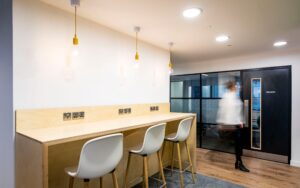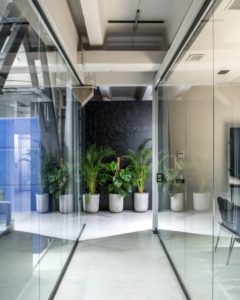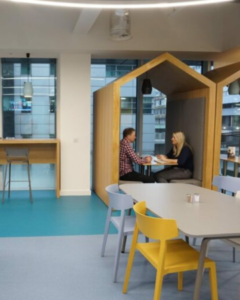We’re all a bit more neurotic about noise now – to the extent that some offices are akin to libraries. Different personalities crave a range of environments, with open plan often struggling to provide the right settings. The near-universal provision of laptops no longer chains people to their desks so there is greater opportunity for people to move to a location that better suits their particular requirements at that time – activity based workplaces in essence. What is best for your organisation can often be difficult to pin down (even more so when many employees seem to be extremely comfortable with their home office environment), so the promise of test and learn with regard to layout is appealing. But does this concept translate to reality?
The rise of small spaces
A recent client workshop emphasised the importance of small spaces for focused work, especially for teams involved in policy setting and analysis. With the growing challenges of noise distraction in the office (“dissatisfaction with noise levels kills productivity” according to Leesman), creating areas where employees can escape, or corral noise has become a significant consideration. Acoustics and zoning were key topics during the client strategy session and when I used the phrase ‘test and learn’ there was a nodding of heads from two or three key stakeholders.
The Space Solution
We recently built two small rooms in our Glasgow office to address the need for private phone calls, virtual meetings, and quiet work, These rooms were designed to be larger than the ‘zoom cupboards’ that gained popularity in 2020, accommodating one person very comfortably and even allowing for two or three individuals for short periods of time. We made one room bookable and the other non-bookable, providing a degree of in-office agility to support changing needs. When choosing between built rooms and flexible furniture solutions, we considered factors such as budget and the space itself. In our case, limited office footprint made it impractical to frequently rearrange furniture, rendering flexibility less relevant.
Test and learn
As workplace designers and furniture specifiers, we understand the value of exploring different options, even if they may not be a perfect fit for every organisation. Testing and learning are vital to identify opportunities and discover what works best. While larger corporations may have the resources and teams to facilitate such endeavours (even to the extent of creating pilot areas where suppliers swap out furniture regularly), SMEs face practical limitations, including lack of in-house facilities management and flexible services infrastructure. Often, like us, they just lack the space to play with.
Furniture Solutions – challenges and opportunities
At first glance, furniture solutions often appear flexible. However, when considering factors like power supply, data connectivity, and feature lighting, these settings can become as immovable as fixed rooms. If building control require you to hard wire meeting pods into fire alarms and sprinkler systems that introduces another level of complexity (and inflexibility). While furniture solutions can be relocated during office moves, significant investments in technology-enabled furniture more often than not become ‘locked and left’ until the next workplace refresh.
It would be valuable to gain insights from furniture professionals to better understand the practicality and feasibility of relocating furniture solutions (those bigger than phone booths anyway). Our in-house experience is that furniture relocation is not a regular occurrence following on the back of staff comments on functionality. It is, as stated, an exercise conducted during extensive refreshes (or even a complete move to a new premises). Sustainability-wise, furniture solutions can be refurbished, thereby extending their life. Another potential plus is the growing discussion around leasing furniture though this concept hasn’t become widespread so far.
The future of built rooms
Perhaps in the future, built rooms will be designed for deconstruction and relocation, aligning with the growing emphasis on sustainability in workplace design. That is the optimistic view. The pessimistic view is that demountable partitions will only ever be floor-to-ceiling, and these days, where rooms for quiet focus are required, more often than not, slab-to-slab partitions are specified. That was the case for the two new rooms in our Glasgow office.
Many SMEs often lack the luxury of frequent redesigns and upgrades, hoping that their initial layout will work long term. This ultimately places more onus on the initial briefing, challenging the client to clearly express their vision. However, by considering different workplace concepts and exploring available opportunities, even smaller organisations can find innovative solutions to enhance their workplace.
Creating a conducive work environment involves finding the right balance between collaboration and focused work. Small meeting spaces, whether fixed or flexible, play a vital role in supporting productivity and employee well-being. While testing and learning are essential for larger organisations with more resources, smaller businesses can also benefit from exploring various workplace options. By understanding the pros and cons of fixed small meeting spaces and flexible furniture solutions, organisations can make informed decisions to create workplaces that promote efficient collaboration and employee satisfaction.




